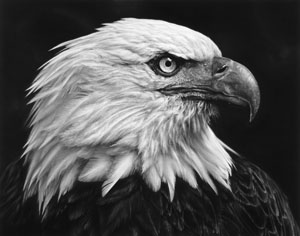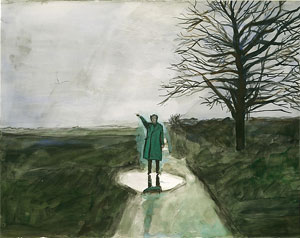Centuries of Political Art
John Haberin New York City
Robert Longo and Anselm Kiefer
Robert Longo crosses decades or even centuries. He goes head to head with others who left unforgettable images of war and revolution.
"Proof: Goya, Eisenstein, Longo" will have anyone wondering: what could the names possibly have in common, across at least three art forms, two continents, and two centuries? The elevator at the Brooklyn Museum opens onto a cavernous space, interrupted by only the exhibition title and a single work—the First Amendment in charcoal by Longo, off to the side. Is the empty chamber just one more assertion of solemnity, from an artist known for anything but? Is the promise of two historic figures to come nothing more than a plea for legitimacy, and where is the art? Show me the proof, he may have you shouting, and in a strange way he does. 
Anselm Kiefer thinks even bigger, with a career that began just a few years before his but a continent away. Kiefer wants to encompass Europe's deep past and his nation's twentieth-century trauma. They fill vast canvases and layer upon layer of neo-expressionist paint, charcoal, shellac, and emulsion. He has moved his studio from Germany to still larger quarters outside Paris to make room for it all. He flexes his muscles even in a small show at the Met Breuer, of work from its collection. "Provocations" has none of his breakthrough paintings from the 1970s or his images of books like the Bible as an opening onto landscape, but it pays off by making his epic theater more vulnerable and personal.
Show me the proof
Robert Longo made his name in the 1980s with Men in the Cities, at a time when Martha Diamond was painting the city from above. They set dancers against white backgrounds, dressed for success and wildly contorted, as if struck by bullets. The disco era was already coming to an end, but they had unmistakable power—thanks to their controlled line, their resemblance to film stills, their reflection on wealth in Reagan years, and the throes of death. Are they now as dated as the Tribeca of Bright Lights, Big City, where men still wore dress shirts and ties on their way to the club scene? Perhaps, but Longo has not just shifted his eye to art and film history. He has been bringing his realism to a fever pitch and his politics into the present.
That opening charcoal of the First Amendment is a plea for the past, right down to its eighteenth-century handwriting, but also for freedom of expression. Yet the show may have you wondering about its premise even past the U-shaped antechamber. It devotes its first room to seven films by Sergei Eisenstein, on contiguous large screens like the walls of a great chapel. It also slows them down by a factor of a hundred, so that you have to work hard to see them advance at all. You can wait a long time for the horrifying woman shot in the eye or the triumphant mutiny on the battleship Potemkin. Did no one tell the museum that films like these made history with montage—rapid and often disruptive editing suited to the Soviet revolution and its betrayal under Stalin?
The films are mesmerizing all the same, and Longo has something serious in mind in rewriting Eisenstein. He and his fellow curator, Kate Fowle, want to insist that great art does slow you down, through the power of images to confront events. He is also drawing connections. The next room has suites of prints by Francisco de Goya, born more than two hundred years before Longo, in 1746. After turning cinema into stasis, he arranges selections from the Spaniard's Bullfighting like successive film stills. He also unites Goya and Eisenstein in their command of darkness and light, precision and intimacy, and of course the disasters of war.
Longo has not just chosen his precursors, but recreated them in his own image, and he does so again in the roughly twenty charcoals that follow. He copies a painting by Joan Mitchell as carefully as the First Amendment, but in a spooky black and white. He transforms the urgent diagonals of The Raft of the Medusa by Théodore Géricault into wilder blurs, facing Syrian refugees on the opposite wall. That large drawing after a photograph strands its subjects high above a dark sea. Other ancestors include Venus with her reflection in a mirror by Titian, a fallen idol at Nineveh, figurines from the office of Sigmund Freud, and implicitly Freud himself. And other current events include the women's march in January 2017, President Obama on the tarmac, the riots in Ferguson, and an athlete's more plaintive protest.
In each case, he is in search of an unmoving, unforgettable image, and, like Melanie Baker in charcoal, he is fascinated by bright lights and his own black dust. He applies it to reflections off an iceberg, a window shattered by a bullet, and the white crest of a bald eagle. He applies it, too, to a plain black rectangle, which hangs between Obama's blackness on one wall and pilgrims crowding into Mecca on another, with the black cube of the Kaaba at their center. He loves images that function as symbols—of climate change, Black Lives Matter, American ideals, or faith. He also loves to draw parallels. Even the plight of refugees as a triptych has a parallel in the raised verticals of nearby works—not to mention in fences by Ai Weiwei around New York.
One can almost forget yet another difference from his precursors: Goya and Eisenstein dreamed up their imagery. The athlete's raised arms may stand for the victim of police violence in a pose of surrender, praise for the dead, or a salute to Black Power, but not thanks to Longo. He is still the appropriation artist of the "Pictures generation"—and still capable of the irony that preserves the gesture of handwriting or color-field painting in a spellbinding copy. He renders the women's march from behind, with a glowing light on the horizon like a glimmer of hope or a ghost, but which one? If you can get past the baloney, you can delight in asking for proof.
A scandal in bohemia
The Met has just one painting by Anselm Kiefer, from 1996, along with two outsize woodcuts and twenty-eight more works on paper, but that one is more than enough. (The show takes up the relatively modest fifth floor, where the Whitney hung some of its own permanent collection before taking up larger quarters downtown to make room for more.) That painting, on coarse burlap, asserts itself by size alone. At more than eighteen feet across, it asks one to take its measure by walking its length and turning one's head. It runs to infinity pictorially as well, with a road straddling the two panels as it barrels up to the horizon. Its brushwork appears to form palpable leaves scattered across it, although Kiefer intends blood-red poppies.
 As ever, he also intends to recover a cultural and political history. A road into depth and a field of poppies are bound to recall Vincent van Gogh. The title, Bohemia Lies by the Sea, quotes an Austrian poet, Ingeborg Bachmann—but Kiefer cannot forget that Hitler began his conquests by annexing modern-day Bohemia, the Sudetenland, and Bachmann saw the German troops enter. He sees history as a saga of collective dreams, but also as present-day limits. Bohemia lies far from the sea, the top edge of the painting presses down on its high horizon, and the twisting road can never reach infinity. History's big gestures are not his alone, but he still feels the limits.
As ever, he also intends to recover a cultural and political history. A road into depth and a field of poppies are bound to recall Vincent van Gogh. The title, Bohemia Lies by the Sea, quotes an Austrian poet, Ingeborg Bachmann—but Kiefer cannot forget that Hitler began his conquests by annexing modern-day Bohemia, the Sudetenland, and Bachmann saw the German troops enter. He sees history as a saga of collective dreams, but also as present-day limits. Bohemia lies far from the sea, the top edge of the painting presses down on its high horizon, and the twisting road can never reach infinity. History's big gestures are not his alone, but he still feels the limits.
Kiefer has a habit of conflating the political and the cultural, much as Hitler demanded both mass extermination and mammoth architecture. He has traveled to northern Europe to connect his bleak but ultimately spiritual vision to that of Edvard Munch, but also to war sites in Poland by the Vistula. He also quotes Richard Wagner and the poetry of Paul Celan, knowing that Hitler, too, loved Wagnerian opera and that Celan, a Romanian Jew, survived a work camp and lost his parents to the camps in World War II. He calls a work on paper The Unknown Masterpiece, after a short story by Honoré de Balzac, but he layers over a photo of Hitler's plans for a Soldier's Hall in Berlin. And there, too, he encounters limits. Hitler's plans never came to fruition, for architecture or for conquest, just as Balzac's hero can never finish his masterpiece.
That artist cannot finish because he cannot stop slathering on paint, and Kiefer would understand. Like the unknown masterpiece, his dark but colorful Brünnhilde's Death tumbles into abstraction. The personal has become the political, but it is still artistic and personal. The Met points out that he gained notoriety by posing in his father's army uniform with a Nazi salute. He adopts the same pose in self-portraits set against a plummeting, barren landscape. When he quotes Wagner again for My Father Pledged Me a Sword in 1975, he takes the text literally.
Then again, maybe not literally, since surely his father did no such thing. Rather, he means it as an aspiration, and he means aspirations as grounds for responsibility. If art has always had the same longing for the infinite as Fascism, at least in his eyes, it has to share responsibility. His salute appears in 1970 encased within a sky-blue hemisphere as Everyone Stands Under His Own Dome of Heaven. Another languid Wagnerian figure contemplates death, like Hamlet, but the skull in her hands could just as well be an artist's palette, most likely his own. When Kiefer calls a landscape and open sky dotted with more blood or flowers Sick Art, he scorns Hitler's equation of blood and soil and the assault on "degenerate art," but he still sounds a little guilty.
Where German Expressionism never distinguished the personal from the cultural or political, Neo-Expressionism has a harder case to make before it can engage the present. Georg Baselitz or Julian Schnabel positively wallows in the personal, while Kiefer obsesses over a past that he himself cannot remember. He was born only in 1945 and grew up in a divided Germany with its own dreams of a nation. Still, he believes, people all too often want to forget, but the past refuses to let go. Big Iron Fist sounds like Fascism, but it refers to a slogan in the Cold War for NATO. He can be portentous or pretentious, even in his book art, but he asks all of western civilization along with him to think big.

"Proof: Goya, Eisenstein, Longo" ran at The Brooklyn Museum through January 7, 2018, Anselm Kiefer at Met Breuer through April 8. Related reviews look at Andrew Topolski, the "Pictures generation," and artist books by Anselm Kiefer.




